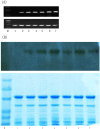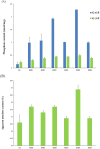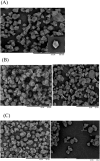Highly phosphorylated functionalized rice starch produced by transgenic rice expressing the potato GWD1 gene
- PMID: 28611462
- PMCID: PMC5469863
- DOI: 10.1038/s41598-017-03637-5
Highly phosphorylated functionalized rice starch produced by transgenic rice expressing the potato GWD1 gene
Abstract
Starch phosphorylation occurs naturally during starch metabolism in the plant and is catalysed by glucan water dikinases (GWD1) and phosphoglucan water dikinase/glucan water dikinase 3 (PWD/GWD3). We generated six stable individual transgenic lines by over-expressing the potato GWD1 in rice. Transgenic rice grain starch had 9-fold higher 6-phospho (6-P) monoesters and double amounts of 3-phospho (3-P) monoesters, respectively, compared to control grain. The shape and topography of the transgenic starch granules were moderately altered including surface pores and less well defined edges. The gelatinization temperatures of both rice flour and extracted starch were significantly lower than those of the control and hence negatively correlated with the starch phosphate content. The 6-P content was positively correlated with amylose content and relatively long amylopectin chains with DP25-36, and the 3-P content was positively correlated with short chains of DP6-12. The starch pasting temperature, peak viscosity and the breakdown were lower but the setback was higher for transgenic rice flour. The 6-P content was negatively correlated with texture adhesiveness but positively correlated with the cohesiveness of rice flour gels. Our data demonstrate a way forward to employ a starch bioengineering approach for clean modification of starch, opening up completely new applications for rice starch.
Conflict of interest statement
The authors declare that they have no competing interests.
Figures



Similar articles
-
Posttranslational Modification of Waxy to Genetically Improve Starch Quality in Rice Grain.Int J Mol Sci. 2021 May 3;22(9):4845. doi: 10.3390/ijms22094845. Int J Mol Sci. 2021. PMID: 34063649 Free PMC article. Review.
-
Simultaneous Repression of GLUCAN WATER DIKINASE 1 and STARCH BRANCHING ENZYME 1 in Potato Tubers Leads to Starch With Increased Amylose and Novel Industrial Properties.Biotechnol J. 2025 Jun;20(6):e70051. doi: 10.1002/biot.70051. Biotechnol J. 2025. PMID: 40491003 Free PMC article.
-
Molecular Structure and Physicochemical Properties of Starches from Rice with Different Amylose Contents Resulting from Modification of OsGBSSI Activity.J Agric Food Chem. 2017 Mar 15;65(10):2222-2232. doi: 10.1021/acs.jafc.6b05448. Epub 2017 Mar 7. J Agric Food Chem. 2017. PMID: 28241110
-
The analysis of the different functions of starch-phosphorylating enzymes during the development of Arabidopsis thaliana plants discloses an unexpected role for the cytosolic isoform GWD2.Physiol Plant. 2017 Aug;160(4):447-457. doi: 10.1111/ppl.12564. Epub 2017 May 8. Physiol Plant. 2017. PMID: 28303594
-
Starch phosphorylation: a new front line in starch research.Trends Plant Sci. 2002 Oct;7(10):445-50. doi: 10.1016/s1360-1385(02)02332-4. Trends Plant Sci. 2002. PMID: 12399179 Review.
Cited by
-
Repression of Sex4 and Like Sex Four2 Orthologs in Potato Increases Tuber Starch Bound Phosphate With Concomitant Alterations in Starch Physical Properties.Front Plant Sci. 2018 Jul 23;9:1044. doi: 10.3389/fpls.2018.01044. eCollection 2018. Front Plant Sci. 2018. PMID: 30083175 Free PMC article.
-
Posttranslational Modification of Waxy to Genetically Improve Starch Quality in Rice Grain.Int J Mol Sci. 2021 May 3;22(9):4845. doi: 10.3390/ijms22094845. Int J Mol Sci. 2021. PMID: 34063649 Free PMC article. Review.
-
Modification of Cassava Root Starch Phosphorylation Enhances Starch Functional Properties.Front Plant Sci. 2018 Oct 30;9:1562. doi: 10.3389/fpls.2018.01562. eCollection 2018. Front Plant Sci. 2018. PMID: 30425722 Free PMC article.
-
Glucan, Water-Dikinase 1 (GWD1), an ideal biotechnological target for potential improving yield and quality in rice.Plant Biotechnol J. 2021 Dec;19(12):2606-2618. doi: 10.1111/pbi.13686. Epub 2021 Sep 3. Plant Biotechnol J. 2021. PMID: 34416068 Free PMC article.
-
Customizing Starch Properties: A Review of Starch Modifications and Their Applications.Polymers (Basel). 2023 Aug 21;15(16):3491. doi: 10.3390/polym15163491. Polymers (Basel). 2023. PMID: 37631548 Free PMC article. Review.
References
-
- Light JM. Modified food starches: why, what, where and how. Cereal Foods World. 1990;35:1081–1092.
-
- Fernbach A. Some observations on the composition of potato starch. C. R. Acad. Sci. 1904;138:428–430.
-
- Blennow A, Engelsen SB, Munck L, Møller BL. Starch molecular structure and phosphorylation investigated by a combined chromatographic and chemometric approach. Carbohyd. Polym. 2000;41(2):163–174. doi: 10.1016/S0144-8617(99)00082-X. - DOI
Publication types
MeSH terms
Substances
LinkOut - more resources
Full Text Sources
Other Literature Sources
Molecular Biology Databases

